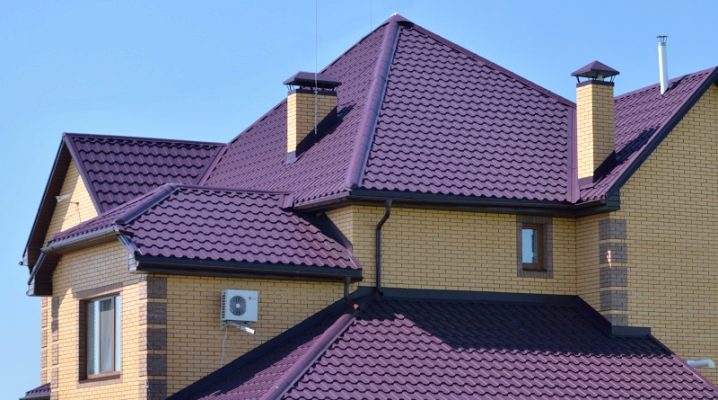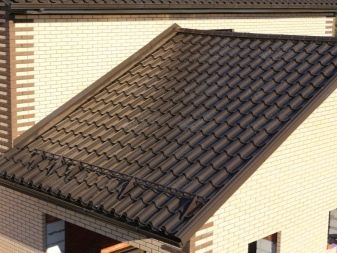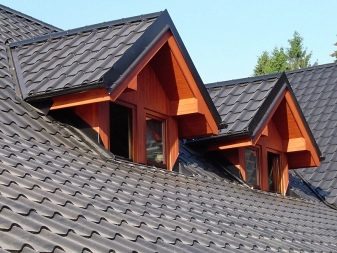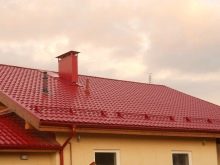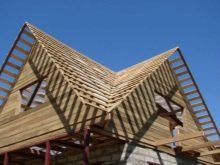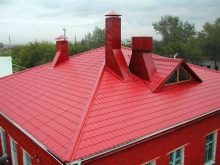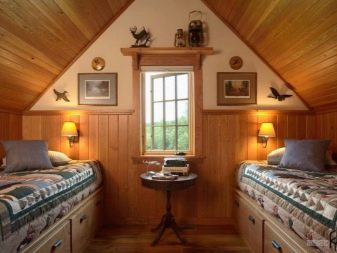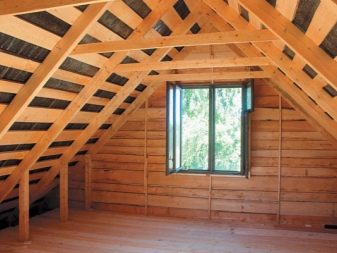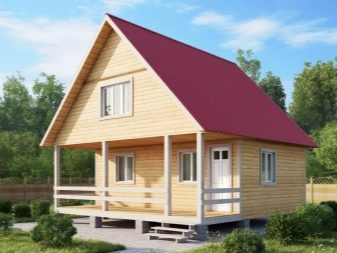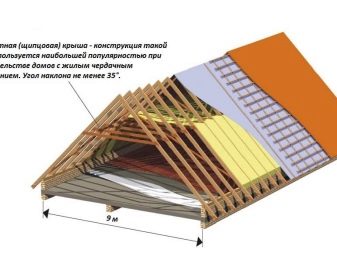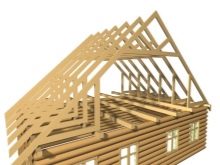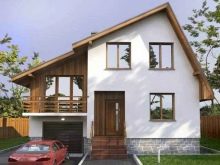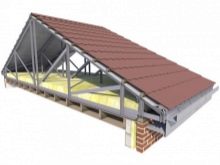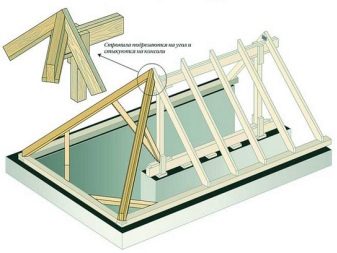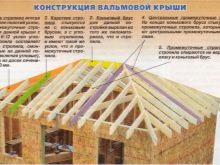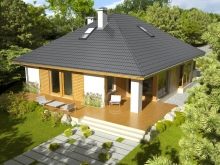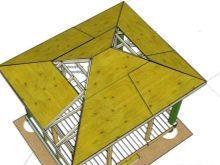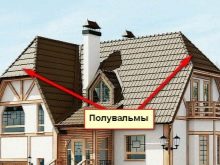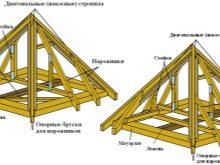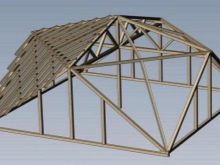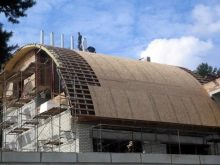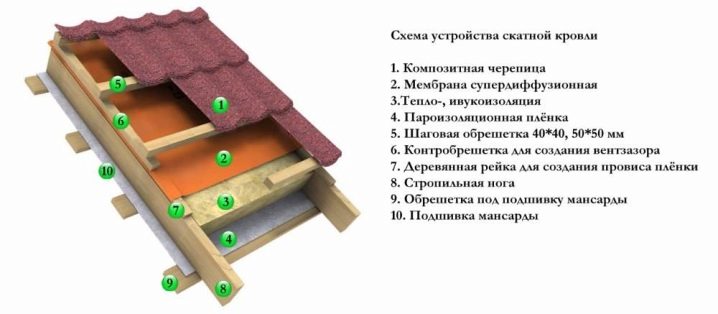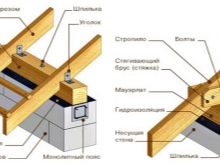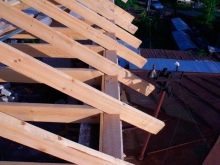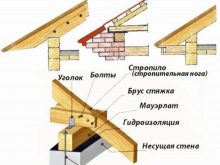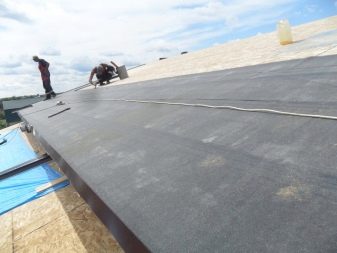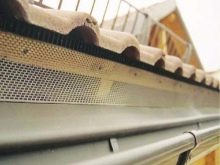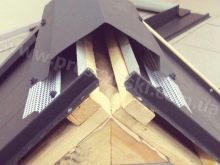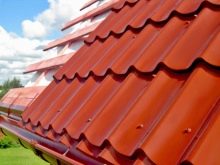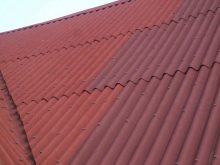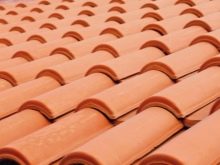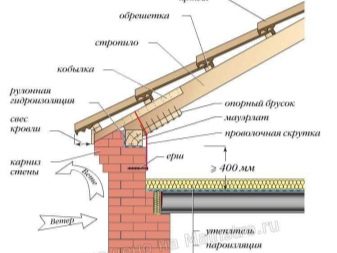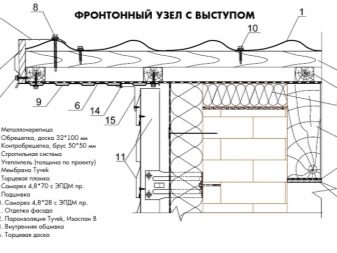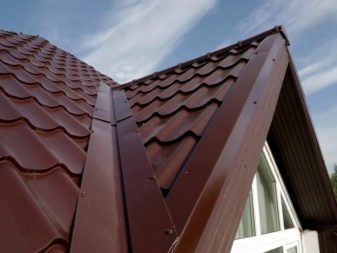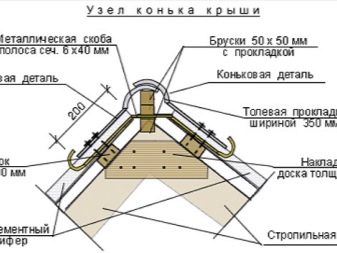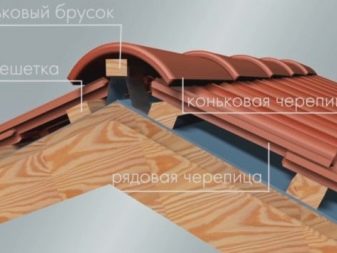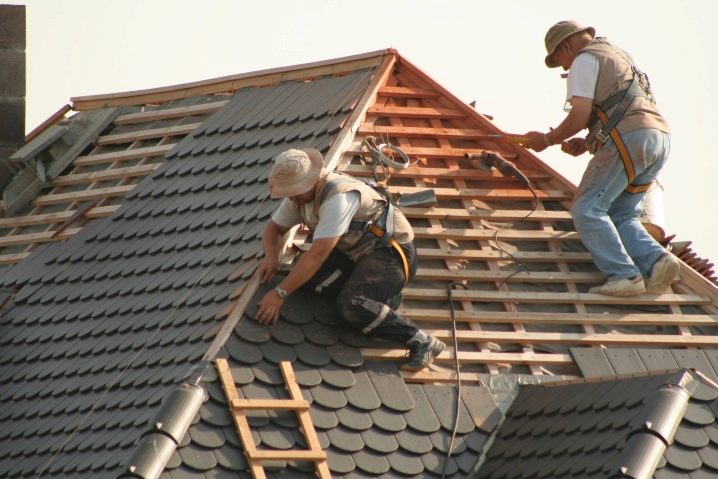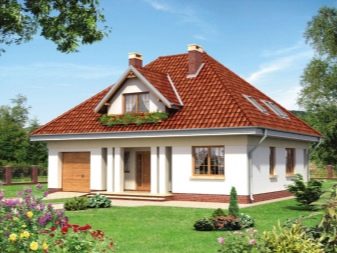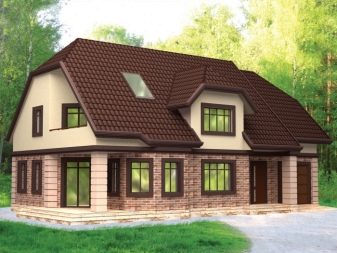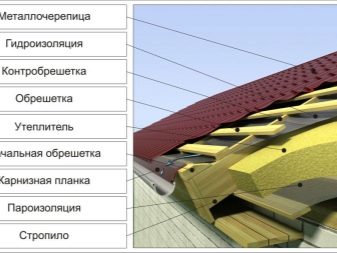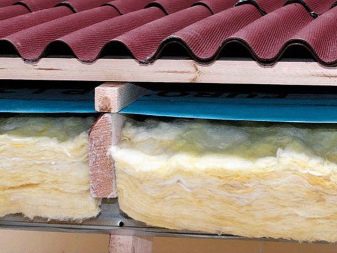What are pitched roofs: forms and the internal structure of roofs
Pitched roofing for private homes is most popular in temperate and northern latitudes. Such designs allow not to accumulate snow cover and rainwater on the surface, inside you can organize a residential attic room, there are other advantages. It is worth considering in more detail, what are pitched roofs, forms and their internal structure.
Features and types of designs
Slope - is the slope of the roof, designed to drain the thawed and rainwater. A private house, depending on the design, can have one or more ramps. The slope may be different, it depends on the climate and weather conditions, the purpose of the attic, usually this value is from 15 to 45 degrees.The device of the roof katov forms the supporting system of rafters, which can be made most of the solid wooden bars.
Such a roof in the form can be single or multiple, hip, tent, gable and some other types. The choice depends on the desired functionality and capabilities of the host. For example, a hip roof and a rafter system to it will be much more difficult to build than a dual-slope roof.
If homemade rafters in a country house are mainly made of wood, then the roofing can be made of various materials. The roof can be wooden or iron - from a metal tile or profile sheet, covered with slate, ondulin, shingles or roofing material. Each type of material has its pros and cons.
Pitched roof, in addition to the rafter frame and cover, has other design detailswhich must be taken into account when designing it: attic hatch or door, gables with or without windows, chimney pipe, ventilation, lightning protection net on holders with lightning rod, heat and waterproofing, ridge, cornices, television antennas.
The space under the sloped roof may be used or not operated. There you can create a pantry, workshop or a full-fledged living room, with large volumes - a few. In this case, the roof must be further warmed, lay ventilation and electrical wiring.
Attic in a country house, used in a place under a sloping roof, is very widespread, and there are many of its projects.
Roof types
Roof with a slope is odnoskatny and mnogoskatnaya. The first type is most often used for buildings with a small area: sheds, gazebos, garages and residential buildings, in which there are 2 - 3 rooms. The slope of the slope of the roof is usually small - up to 30 degrees. It is easier to build a frame for it than for multi-skating variants, there are original designs that have a beautiful visual appearance.
The most common type of roofing for private houses is a double slope.which is actively used in construction today. Most often in profile it has the shape of an isosceles triangle, gables vertical with angles of inclination of the sides 15, 30, 40 and 45 degrees.
Such constructions make it possible to effectively get rid of storm water and snow cover without manual cleaning, provide useful space under the roof, look nice in the summer cottage.
Their construction is simplified by the fact that due to the wide distribution there is a huge number of projects, instructions for the construction of the truss system and roofing.
Duplex roof profile is often symmetrical. More rarely there are projects of roofs with different slopes, their length and, accordingly, the angle of inclination to the horizon differ. This design looks very original, it often provides for the installation of window openings on one of the ramps. The truss system created for him is practically the same as the symmetrical design.
The three-pitch roof is practically the same double-pitch roof, only truncated from one of the sides. One of the slopes in the form of an isosceles triangle, the other two are trapezoid shapes. The truncation can be complete - from the ridge to the base of the roof, or partial, then a section of a straight pediment remains. Similar versions of roofs are widespread in our country, they have traditionally been built for many centuries.They are now popular not only for residential buildings, but also for garages, sheds and other outbuildings.
Widespread in the suburban construction of the roof with slopes, consisting of several planes. Each of them has a different angle of inclination. The shape of the pediment is a pentagon or a trapezoid. Pitched roof with a five-sided profile retains its protective characteristics, while inside there is more free space for the arrangement of a full-fledged living room.
Hip roofs are two-pitched, only their gables are truncated at a certain angle, therefore two stingrays are in the form of isosceles triangles, and two are in the form of a trapezium, the ridge is shortened. Such structures are widespread in the Netherlands and Scandinavian countries, where effective protection of the roof from a powerful wind is required.
Indeed, due to its shape, such gusts are less terrible than strong gusts.
Schemes of the roof system of such a roof are complicated, but with experienced hands it will not be difficult to build the rafters on your own.
In half-halt roofs, the gable truncation is not fully completed to the base, such structures are used, for example, if they want to create additional side windows in the attic.The drawing of such a roof is more complicated than that of the hip, it has ramps in several inclined planes in the form of a trapezoid and a triangle, it can be pentagonal, six-fold, or other complex structures. The half-hinged roof has an original look and is well protected from the wind.
Tent roofing is used for square-shaped buildings. It has the form of a regular pyramid, the slopes are triangular, located at an angle, that is, there are no gables. Often this type is used for gazebos and other small buildings.
Multi-tip roof construction is also most often used for square houses, but it can also be built on a rectangular building. In fact, it is octagonal with slopes that have the same triangular shape. Most often, the projects of such a roof are presented with a complex roof frame, the presence of endov and an intricate system of eaves and weirs.
The diagonal roof for square-shaped buildings has 4 diamond shaped slopes. The broken surface complicates the installation of the truss system and floor covering. But such projects look very original.
Finally, the shape of the roof can be vaulted, that is streamlined, in a semicircular profile. Such a structure will reliably protect from wind and precipitation, but it is difficult to build it.Most often, these roofs are not installed on residential buildings, but on gazebos and small outbuildings.
Nodes: Functions and Features
Any pitched roof has a complex structure with many details, each of which performs a specific function. All of them are important for reliable and safe operation of a residential building, so it is worth considering in more detail the characteristics and functions of each node.
In the most general case, the roof with ramps has 4 nodes, each of which is divided into smaller parts:
- roof system - the main support frame of the pitched roof;
- roofing carpet - an insulating layer that protects from moisture, steam and cold;
- ventilation system;
- roofing materials used for exterior cladding;
- additional elements of the roof.
The rafter system consists of a mauerlat, struts, puffs, struts and a sheathing, there are other nodes. The task of the rafters is to support the roofs of the roof with insulated insulation and external coating at a certain angle. Layout schemes and connections of all roof beams and materials should provide the burden placed on them.
The minimum slope of the slopes can be 15 degrees, the maximum 45, the steeper it is, the more rigid the construction of the rafters should be.
Mauerlat - timber with a wide cross-section, fastened directly to the walls of the house, and being their link with rafters. It is based on it inclined beams. Puffs are bars that are perpendicular to the mounting plate and run in several rows throughout the roof, their number depends on the length of the building. Vertical posts and inclined struts supporting the rafters of the roof rest on the beams of the puffs.
Combined puffs, upright stands and sloping struts form trusses. They should be chosen depending on the size of the house. Wooden parts are fastened together with screws, anchors or corners.
Roofing carpet is laid on the rafter frame and serves to protect against wind, cold, moisture and steam. It completely covers the roof, a final decorative covering is installed on top of it. In accordance with the set of rules on the roofs of the joint venture 17-13330-2011, the roofing carpet is formed by continuous or partial gluing of layers of heat, water and vapor insulation, roll, sprayed, coating or sheet materials, screed or profiled sheet.
An important point when installing a pitched roof is ventilation, the installation of which you need to take care of even before laying a protective and decorative coating.Thanks to it, the efficiency of insulation increases, there is no accumulation of condensate between the layers, and the service life of the wooden parts of the rafters increases.
For ventilation use special elements - airways, which are of several types.
- eaves - are installed along eaves overhangs between the wall and the roof in the form of continuous slots 20-25 mm wide (continuous) or individual holes (pin holes);
- ridge produc do on the ridge in the form of a continuous continuous slit width of 20 - 50 mm or individual holes - flyugarok;
- aerators - devices in the form of tubes with caps, installed in the roof covering, ventilation and removal of water vapor in them occurs due to temperature and pressure drops outside and inside the housing.
Exterior roofing provides additional protection from external weather factors and is a decorative element. In order to look at the roof of the house representatively, today created a lot of finishing materials.
It is necessary to choose such facing that it served for a long time and harmoniously fit into the exterior of the building.
- Metal roofing and profile metal sheets are one of the most popular materials for roof cladding. They are lightweight, durable, and the outer polymer coating reliably protects against cold, moisture and ultraviolet radiation, while there is a choice of many colors.
- Ondulin for cladding a pitched roof is good because it is light and easy to install, is a good heat insulator, protected from moisture, has a low cost. Different colors of this material are presented.
- The usual tile made of mineral raw materials, is also widely used in the arrangement of the roof, has a noble natural look. The disadvantages are its large weight - you need to build strong rafters, and the fragility of this material.
In addition to the external facing of the pitched roof, additional elements are available. They are important for the completion of a solid construction, perform useful protective functions.
The eaves assembly covers the lower part of the roof and serves to protect the roof system from the outside. Its strips are usually attached to the roof with an overlap of 10 - 15 cm. Fastening is carried out using roofing screws with rubber insulating gasket at a distance of 20 - 30 cm in the entire length of the ceiling.
The gable roof assembly serves as an additional support to the truss system from the side, is a decorative element, and can serve as a wall with windows for an attic. The gable can be made of wood, lathing with siding, profile sheet, brick or gas silicate blocks. The roof covering of the gable knot is closed with an end plate. It performs a decorative function, protects metal roofing or other material from moisture and razbaltyvaniya under the action of the wind.
Endova is a connecting node between two slopes of the roof, representing a concave angle. Without it you can not do in mnogoschittsovy, bubinovy or T-shaped roofs. The endovaya structure is a metal or plastic corner bar that is attached to the rafters with an overlap of up to 10 cm.
Proper installation of endovy necessary for reliable protection of the roof from the weather and effective rainfall.
The junction bars are installed in those places where the roof covering is adjacent to the wall of the house or chimney pipe. They must provide reliable sealing; in the absence of cracks, they can be additionally treated with silicone or sealant, provided with rubber gaskets.The junction strips are made of metal or plastic, mounted on anchors or screws.
The ridge knot is installed at the joint of two slopes and is the final stage of mounting the roof covering. It must be mounted on top of the cladding material. Fastening is carried out on the self-tapping screws with a step of 10 - 15 cm, the overlap should be at least 10 cm. For the reliability of the design, you should choose a metal ridge that matches the color with a hint of roofing.
The knot must be made airtight, but if necessary, provide with ridge products.
How to choose an option: tips
The choice of the shape of the pitched roof depends on several factors: climate and weather conditions, the area of the building, its width, the purpose of the attic. Of course, one of the main selection criteria is financial possibilities. Complex projects of hip, gable and hipped roofs require a large number of expensive building materials and professional responsible work of experienced roofers.
An important role is played by the size and shape of a private house. If the width of the building is 9–18 m, then it is optimal to choose classic triangular, for 12–24 m, trapezoidal ones are usually used, for 24–36 m complex polygonal. If the building is square, then it is optimal to choose a hip or tambourine roof.
Under conditions of strong wind and heavy rainfall in winter, the most successful option would be to install a hip or semi-hinged roof. Although difficult to install rafters, it will reliably serve for many years and protect a residential building from adverse weather conditions.
The coating is better to choose a modern, durable and pleasant-looking. Do not use old, irrelevant materials for roofing: slate, roofing felt. It is better to spend a certain amount on a beautiful and reliable roof. The leader among the modern facing materials for the roof are metal and colored metal profile sheet.
"Pie": requirements
Insulation cake for the pitched roof must reliably protect from moisture, cold, faith and steam. In addition, it must be fireproof, for this uses several modern efficient and non-combustible materials.
Do not neglect the fire safety, the slightest spark in the chimney system can lead to the most disastrous consequences.
Insulation of a pitched roof is often multi-layered: first comes protection from steam, most often polyethylene film. Then heat insulation is laid, for which you can choose effective and harmless roofing materials: mineral wool, penofol, penoplex, expanded polystyrene.In the end, it is necessary to lay a layer of waterproofing, to seal the joints and places of junction with the wall and truss frame for tightness.
Calculation and installation
It is necessary, first of all, to decide on the choice of the shape of the roof, materials and design of the truss system. In order to properly stock up with the necessary amount of materials for the rafters, lathing, insulation, cladding, fastening and additional elements, it is necessary to make a plan for the future roof, preferably in two projections, with an indication of the dimensions and places of joining of parts.
Before building rafters, it is necessary to equip a place for the preparation of individual parts on the ground, to assemble reliable scaffolding sufficient in height for convenient and safe construction. Harvested bars are cut to size with a hacksaw or chainsaw, then treated with antiseptic and refractory mastic, kept until completely dry.
Do-it-yourself installation of rafters begins with the fastening of the power plate and the puffs perpendicular to it. Their number depends on the length of the roof, on average they are laid at a distance of 1 - 1.5 m. Next, the central and additional sunbeds must be placed on the puffs. They are supported by racks and struts.Then a slope is made of rafters, which at the junction are connected by a ridge run. The technology of connecting all wooden elements can be different: in the groove, on anchors, screws with nuts or nails.
When the roof frame is fully finished, it is sheathed over the entire area. It is necessary to support the insulating "cake" and the outer lining. For crates usually choose thin wooden slats, which are attached to the nails. Directly to it lay the layers of insulation, then make the lining of the selected material.
The construction of the roof ends with the installation of additional elements: end or wind and cornice strips, connections to the walls, chimney pipes and ventilation, ridge and endovy, lightning rods and ground flow systems.
In general, the creation of a project with drawings and installation of the roof with slopes can be done independently, having a set of necessary tools and materials. Experienced craftsmen in the amount of 2 - 3 people cope with a similar task in a few days.
For more information about the process of building a roof, see the video below.
